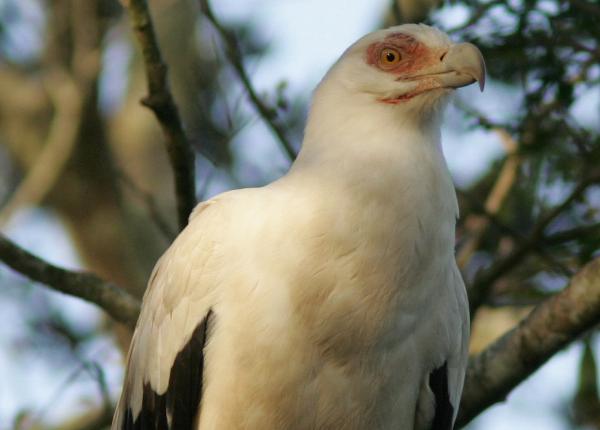Did You Know?
- The Palm-nut Vulture is rare in the raptor world - more than half its diet is composed of plants, particularly palm fruits.
- This species was once known as the Vulturine Fish-eagle
- The intensity in color of the bare skin found on this vulture's face is affected by the fruits it eats, and also by its mood! The color can range from orange to bright red.
- Unlike other vultures, the Palm-nut Vulture has feathers on its head!
How The Peregrine Fund is Helping
The Peregrine Fund has been studying vultures in Kenya and other African nations since the early 1990s. We conduct environmental education programs in the countries in which we work to help teach people about the importance of protecting birds of prey and their habitats, and we provide hands-on training to students and local biologists. Our efforts in scientific research, habitat conservation, education, and community development help conserve raptors on a global scale. We also supply literature to researchers from our avian research library, which helps scientists around the world gather and share important information on raptor conservation.
Where it Lives
This species is found in the African continent, including in parts of South Sudan, Kenya, Angola and South Africa. This lovely vulture prefers more open habitat such as savannas, lakes, mangroves, forest edges, along the coast, and of course, in areas of oil palm plantations. It is generally found from sea level to around 1,500 meters.
What it Does
This beautiful vulture is graced with a lovely white, feathered head, face, neck, upper feathers, and thighs. This contrasts beautifully with its shiny black back and wings. Its tail is also black with a white tip. Biologists have observed that this bird spends much of its time perched near food trees, or walking about on beaches, sandbars, and river banks. It generally does not soar as much as other vultures and can be seen commuting between feeding and nesting areas. It roosts in small groups in trees, but forages singly. Their vocalizations have been described low growls, cawing, hissing and quacking!
Why it Needs our Help
This species is classified as Least Concern. It is common throughout much of its range and has even expanded its range in some areas, where oil palms have been introduced. Because it relies on a heavily vegetarian diet, this species isn't often exposed to deliberate or unintentional poisoning that threatens so many other vulture species in Africa.
What it Eats
True to its name, the Palm-nut Vulture feeds primarily on the fruits of different palm trees, as well as dates and even some grains. However, it does also prey on other animals. Here is a list of just some of the items on this vulture's menu: bird nestlings, snakes, fresh fish which it grabs from the surface of the water in the manner of a fish-eagle, crabs, mollusks, rodents, giant snails, dung beetles, termites, flying ants, and locusts. It also sometimes feeds on carrion - carcasses of animals that have died from other causes, such as being hit by a car. If there is a grassfire nearby, you might also find Palm-nut Vultures. They will hunt small prey fleeing the flames and smoke.
Nests, Eggs, and Young
Though some vulture species will nest in close proximity to larger numbers of other vultures, the Palm-nut Vulture does not. Though it might nest within 1 kilometer or so of another breeding pair. These vultures build large stick nests, which they line with soft leaves, animal dung, or even palm fronds. They will construct their nest high up in a tree, often near water. They often reuse the same nest year after year. When the time is right, the female will lay one lone egg. . Both the male and female will take turns incubating the eggs which they might do for 35–50 days, until their young chick hatches. Once it does, both parents will also care for it to make sure it grows into a healthy vulture! When it is around 3 months old, it will be ready to fly for the first time.
Palm-nut Vulture and the World Center for Birds of Prey
Though very far from Palm-nut Vulture habitat, at the World Center for Birds of Prey, you will meet one of our best raptor ambassadors, Lucy, the friendly Turkey Vulture. You can visit her outside her chamber or watch her fly during our bird presentations. This is a wonderful chance to see a Turkey Vulture up close and learn to appreciate their unique beauty and amazing adaptations for survival. Additionally, the World Center for Birds of Prey offers fun ways to learn about birds of prey. Interactive activities, tours, interesting videos and a children's room with activities from coloring sheets to quizzes to costumes. There is also a touch table with owl feathers and other natural objects for exploration.
References:
Global Raptor Information Network. 2022. Species account: Palm-nut Vulture Gypohierax angolensis. Downloaded from http://www.globalraptors.org on 23 Sep. 2022
Kemp, A. C. and G. M. Kirwan (2020). Palm-nut Vulture (Gypohierax angolensis), version 1.0. In Birds of the World (J. del Hoyo, A. Elliott, J. Sargatal, D. A. Christie, and E. de Juana, Editors). Cornell Lab of Ornithology, Ithaca, NY, USA.










